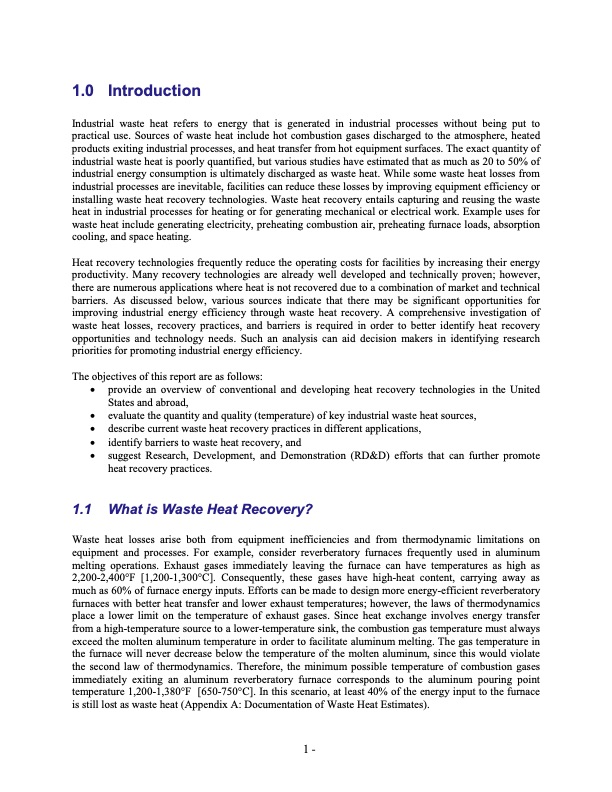
PDF Publication Title:
Text from PDF Page: 016
1.0 Introduction Industrial waste heat refers to energy that is generated in industrial processes without being put to practical use. Sources of waste heat include hot combustion gases discharged to the atmosphere, heated products exiting industrial processes, and heat transfer from hot equipment surfaces. The exact quantity of industrial waste heat is poorly quantified, but various studies have estimated that as much as 20 to 50% of industrial energy consumption is ultimately discharged as waste heat. While some waste heat losses from industrial processes are inevitable, facilities can reduce these losses by improving equipment efficiency or installing waste heat recovery technologies. Waste heat recovery entails capturing and reusing the waste heat in industrial processes for heating or for generating mechanical or electrical work. Example uses for waste heat include generating electricity, preheating combustion air, preheating furnace loads, absorption cooling, and space heating. Heat recovery technologies frequently reduce the operating costs for facilities by increasing their energy productivity. Many recovery technologies are already well developed and technically proven; however, there are numerous applications where heat is not recovered due to a combination of market and technical barriers. As discussed below, various sources indicate that there may be significant opportunities for improving industrial energy efficiency through waste heat recovery. A comprehensive investigation of waste heat losses, recovery practices, and barriers is required in order to better identify heat recovery opportunities and technology needs. Such an analysis can aid decision makers in identifying research priorities for promoting industrial energy efficiency. The objectives of this report are as follows: • provide an overview of conventional and developing heat recovery technologies in the United States and abroad, • evaluate the quantity and quality (temperature) of key industrial waste heat sources, • describe current waste heat recovery practices in different applications, • identify barriers to waste heat recovery, and • suggest Research, Development, and Demonstration (RD&D) efforts that can further promote heat recovery practices. 1.1 What is Waste Heat Recovery? Waste heat losses arise both from equipment inefficiencies and from thermodynamic limitations on equipment and processes. For example, consider reverberatory furnaces frequently used in aluminum melting operations. Exhaust gases immediately leaving the furnace can have temperatures as high as 2,2002,400°F [1,2001,300°C]. Consequently, these gases have highheat content, carrying away as much as 60% of furnace energy inputs. Efforts can be made to design more energyefficient reverberatory furnaces with better heat transfer and lower exhaust temperatures; however, the laws of thermodynamics place a lower limit on the temperature of exhaust gases. Since heat exchange involves energy transfer from a hightemperature source to a lowertemperature sink, the combustion gas temperature must always exceed the molten aluminum temperature in order to facilitate aluminum melting. The gas temperature in the furnace will never decrease below the temperature of the molten aluminum, since this would violate the second law of thermodynamics. Therefore, the minimum possible temperature of combustion gases immediately exiting an aluminum reverberatory furnace corresponds to the aluminum pouring point temperature 1,2001,380°F [650750°C]. In this scenario, at least 40% of the energy input to the furnace is still lost as waste heat (Appendix A: Documentation of Waste Heat Estimates). 1PDF Image | Waste Heat to Energy Tech Opportunities in US Industry

PDF Search Title:
Waste Heat to Energy Tech Opportunities in US IndustryOriginal File Name Searched:
waste_heat_recovery.pdfDIY PDF Search: Google It | Yahoo | Bing
NFT (Non Fungible Token): Buy our tech, design, development or system NFT and become part of our tech NFT network... More Info
IT XR Project Redstone NFT Available for Sale: NFT for high tech turbine design with one part 3D printed counter-rotating energy turbine. Be part of the future with this NFT. Can be bought and sold but only one design NFT exists. Royalties go to the developer (Infinity) to keep enhancing design and applications... More Info
Infinity Turbine IT XR Project Redstone Design: NFT for sale... NFT for high tech turbine design with one part 3D printed counter-rotating energy turbine. Includes all rights to this turbine design, including license for Fluid Handling Block I and II for the turbine assembly and housing. The NFT includes the blueprints (cad/cam), revenue streams, and all future development of the IT XR Project Redstone... More Info
Infinity Turbine ROT Radial Outflow Turbine 24 Design and Worldwide Rights: NFT for sale... NFT for the ROT 24 energy turbine. Be part of the future with this NFT. This design can be bought and sold but only one design NFT exists. You may manufacture the unit, or get the revenues from its sale from Infinity Turbine. Royalties go to the developer (Infinity) to keep enhancing design and applications... More Info
Infinity Supercritical CO2 10 Liter Extractor Design and Worldwide Rights: The Infinity Supercritical 10L CO2 extractor is for botanical oil extraction, which is rich in terpenes and can produce shelf ready full spectrum oil. With over 5 years of development, this industry leader mature extractor machine has been sold since 2015 and is part of many profitable businesses. The process can also be used for electrowinning, e-waste recycling, and lithium battery recycling, gold mining electronic wastes, precious metals. CO2 can also be used in a reverse fuel cell with nafion to make a gas-to-liquids fuel, such as methanol, ethanol and butanol or ethylene. Supercritical CO2 has also been used for treating nafion to make it more effective catalyst. This NFT is for the purchase of worldwide rights which includes the design. More Info
NFT (Non Fungible Token): Buy our tech, design, development or system NFT and become part of our tech NFT network... More Info
Infinity Turbine Products: Special for this month, any plans are $10,000 for complete Cad/Cam blueprints. License is for one build. Try before you buy a production license. May pay by Bitcoin or other Crypto. Products Page... More Info
| CONTACT TEL: 608-238-6001 Email: greg@infinityturbine.com | RSS | AMP |